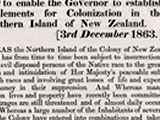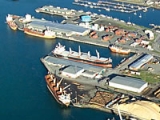What happened that day?
See historic events for any day of the year by entering the date below. Why not try your birthday?
Kiwi of the Week
Today in History

1863 Land confiscation law passed
This law allowed for the confiscation (raupatu) of Maori land as punishment of those North Island tribes who were deemed to have been in rebellion against the British Crown in the early 1860s. New settlers would be introduced onto confiscated lands.
On the eve of the British invasion of the Waikato in July 1863, the government issued an order. This required all Maori living in the Manukau district and on the Waikato frontier north of the Mangatawhiri stream to take the oath of allegiance to the Queen and to give up any weapons in their possession. Maori who refused ‘must retire to the Waikato’.
Those not complying with this instruction were said to have ‘taken up arms with the object of attempting the extermination or expulsion of the European settlers and are now engaged in open rebellion against Her Majesty's authority’. They were warned by proclamation that they:
must take the consequences of their acts, and they must understand that they will forfeit the right to the possession of their lands guaranteed to them by the Treaty of Waitangi, which lands will be occupied by a population capable of protecting for the future the quiet and unoffending from the violence with which they are now so constantly threatened.
The House of Representatives sought to enforce this punishment via the New Zealand Settlements Act. The Act allowed for the seizure of up to 1.4 million hectares of Maori land, but it was intended as more than a punishment. Confiscated land would help pay for the cost of the war and help ‘tame the frontier’. In addition, military settlers would receive sections of land as payment for service, further entrenching European control.
Governor George Grey called for confiscation levels to correspond with levels of guilt. The settler government of Alfred Dommett was determined to make Maori pay and wanted as much land as it could get.
Under this legislation Waikato lost almost all of their land and Ngati Haua about a third. But kupapa (pro-government or neutral) Maori also lost land as the issue rapidly became one not so much of guilt but convenience. Taranaki Maori lost just over 505m ha. Ngati Maniapoto territory was left untouched as it was too difficult to reach and not considered worth the effort. In the end only 647m ha of confiscated land was occupied.
Internal links
External links

1960 Bluff Island Harbour opened
The 40-hectare (100-acre) man-made Island Harbour, which took eight years to construct, is the centrepiece of the modern port facilities at Bluff, the southern-most commercial deepwater port in New Zealand.
The port of Bluff, nestled beneath the towering 265-metre-high Motupohue (Bluff Hill), claims to be the oldest continuously occupied European settlement in New Zealand. European whalers and sealers may have visited the area in the 1790s. When a Sydney vessel, the Perseverance, entered the harbour in 1813 they found a Ngai Tahu settlement on the seaward side of Motupohue. Other flax traders, whalers and sealers visited over the following decade. Whaler James Spencer, who first arrived in 1823, returned the following year and established a trading post at Bluff to supply visiting ships, becoming the first permanent European resident. A shore whaling station was established in 1836.
Construction of the Town Wharf began in 1863 and within four years Bluff (or Campbelltown, as it was officially known until 1917) was linked to Invercargill by one of New Zealand’s earliest railway lines. By the end of the century it was a thriving export port for dairy products and frozen meat. In 1952 a major expansion of port facilities began when it was decided to reclaim an area of shallow sandbanks and build what is now the Island Harbour. This man-made island was officially opened on 3 December 1960. Further reclamation continued until 1982, when the No.8 berth was completed.
Facilities on the Island Harbour include grain silos, extensive cool stores, a loader for wood chips and other bulk cargoes, tallow storage, and New Zealand’s largest ship-lift (with a capacity of more than 1000 tonnes). The eastern side of the harbour is dominated by the giant Tiwai Point aluminium smelter, opened in 1971, which produces a quarter of a million tonnes of aluminium each year.
Today, the port of Bluff is operated by South Port New Zealand Ltd, and has an annual cargo throughput of around 1.7 million tonnes. Imports include alumina and other raw materials for the smelter, petroleum products, fertilizer and paper pulp. Major export products include aluminium, meat, wool, tallow, forest products (ranging from logs to furniture), fish and grain.




















